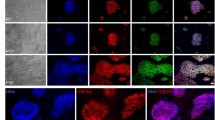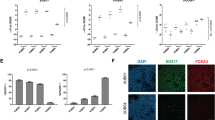Abstract
Human embryonic stem cells (hESCs) are routinely cultured on fibroblast feeder layers or in fibroblast-conditioned medium (CM). Bone morphogenetic proteins (BMPs) have previously been shown to induce hESC differentiation, in apparent contrast to mouse embryonic stem (ES) cells, in which BMP4 synergizes with leukemia inhibitory factor (LIF) to maintain self-renewal. Here we demonstrate that hESCs cultured in unconditioned medium (UM) are subjected to high levels of BMP signaling activity, which is reduced in CM. The BMP antagonist noggin synergizes with basic fibroblast growth factor (bFGF) to repress BMP signaling and sustain undifferentiated proliferation of hESCs in the absence of fibroblasts or CM. These findings suggest a basic difference in the self-renewal mechanism between mouse and human ES cells and simplify the culture of hESCs.
This is a preview of subscription content, access via your institution
Access options
Subscribe to this journal
Receive 12 print issues and online access
$259.00 per year
only $21.58 per issue
Buy this article
- Purchase on Springer Link
- Instant access to full article PDF
Prices may be subject to local taxes which are calculated during checkout





Similar content being viewed by others
References
Thomson, J.A. et al. Embryonic stem cell lines derived from human blastocysts. Science 282, 1145–1147 (1998).
Reubinoff, B.E., Pera, M.F., Fong, C.Y., Trounson, A. & Bongso, A. Embryonic stem cell lines from human blastocysts: somatic differentiation in vitro. Nat. Biotechnol. 18, 399–404 (2000).
Evans, M.J. & Kaufman, M.H. Establishment in culture of pluripotential cells from mouse embryos. Nature 292, 154–156 (1981).
Martin, G.R. Isolation of a pluripotent cell line from early mouse embryos cultured in medium conditioned by teratocarcinoma stem cells. Proc. Natl. Acad. Sci. USA 78, 7634–7638 (1981).
Smith, A.G. et al. Inhibition of pluripotential embryonic stem cell differentiation by purified polypeptides. Nature 336, 688–690 (1988).
Williams, R.L. et al. Myeloid leukaemia inhibitory factor maintains the developmental potential of embryonic stem cells. Nature 336, 684–687 (1988).
Ying, Q.L., Nichols, J., Chambers, I. & Smith, A. BMP induction of Id proteins suppresses differentiation and sustains embryonic stem cell self-renewal in collaboration with STAT3. Cell 115, 281–292 (2003).
Humphrey, R.K. et al. Maintenance of pluripotency in human embryonic stem cells is STAT3 independent. Stem Cells 22, 522–530 (2004).
Amit, M. et al. Clonally derived human embryonic stem cell lines maintain pluripotency and proliferative potential for prolonged periods of culture. Dev. Biol. 227, 271–278 (2000).
Xu, R.H. et al. BMP4 initiates human embryonic stem cell differentiation to trophoblast. Nat. Biotechnol. 20, 1261–1264 (2002).
Pera, M.F. et al. Regulation of human embryonic stem cell differentiation by BMP-2 and its antagonist noggin. J. Cell Sci. 117, 1269–1280 (2004).
Price, P.J., Goldsborough, M.D. & Tilkins, M.L. Embryonic stem cell serum replacement. in International Patent Application. (1998).
Xu, C. et al. Feeder-free growth of undifferentiated human embryonic stem cells. Nat. Biotechnol. 19, 971–974 (2001).
Liu, F. et al. A human Mad protein acting as a BMP-regulated transcriptional activator. Nature 381, 620–623 (1996).
Suzuki, A., Chang, C., Yingling, J.M., Wang, X.F. & Hemmati-Brivanlou, A. Smad5 induces ventral fates in Xenopus embryo. Dev. Biol. 184, 402–405 (1997).
Kawai, S. et al. Mouse smad8 phosphorylation downstream of BMP receptors ALK-2, ALK-3, and ALK-6 induces its association with Smad4 and transcriptional activity. Biochem. Biophys. Res. Commun. 271, 682–687 (2000).
Hsu, D.R., Economides, A.N., Wang, X., Eimon, P.M. & Harland, R.M. The Xenopus dorsalizing factor Gremlin identifies a novel family of secreted proteins that antagonize BMP activities. Mol. Cell 1, 673–683 (1998).
Lopez-Rovira, T., Chalaux, E., Massague, J., Rosa, J.L. & Ventura, F. Direct binding of Smad1 and Smad4 to two distinct motifs mediates bone morphogenetic protein-specific transcriptional activation of Id1 gene. J. Biol. Chem. 277, 3176–3185 (2002).
Korchynskyi, O. & ten Dijke, P. Identification and functional characterization of distinct critically important bone morphogenetic protein-specific response elements in the Id1 promoter. J. Biol. Chem. 277, 4883–4891 (2002).
Draper, J.S. et al. Recurrent gain of chromosomes 17q and 12 in cultured human embryonic stem cells. Nat. Biotechnol. 22, 53–54 (2004).
Anisimov, S.V. et al. SAGE identification of gene transcripts with profiles unique to pluripotent mouse R1 embryonic stem cells. Genomics 79, 169–176 (2002).
Sperger, J.M. et al. Gene expression patterns in human embryonic stem cells and human pluripotent germ cell tumors. Proc. Natl. Acad. Sci. USA 100, 13350–13355 (2003).
Brandenberger, R. et al. Transcriptome characterization elucidates signaling networks that control human ES cell growth and differentiation. Nat. Biotechnol. 22, 707–716 (2004).
Richards, M., Tan, S.P., Tan, J.H., Chan, W.K. & Bongso, A. The transcriptome profile of human embryonic stem cells as defined by SAGE. Stem Cells 22, 51–64 (2004).
Amit, M., Shariki, C., Margulets, V. & Itskovitz-Eldor, J. Feeder layer- and serum-free culture of human embryonic stem cells. Biol. Reprod. 70, 837–845 (2004).
Sato, N., Meijer, L., Skaltsounis, L., Greengard, P. & Brivanlou, A.H. Maintenance of pluripotency in human and mouse embryonic stem cells through activation of Wnt signaling by a pharmacological GSK-3–specific inhibitor. Nat. Med. 10, 55–63 (2004).
Pera, E.M., Ikeda, A., Eivers, E. & De Robertis, E.M. Integration of IGF, FGF, and anti-BMP signals via Smad1 phosphorylation in neural induction. Genes Dev. 17, 3023–3028 (2003).
Nakayama, K. et al. Receptor tyrosine kinases inhibit bone morphogenetic protein-Smad responsive promoter activity and differentiation of murine MC3T3–E1 osteoblast-like cells. J. Bone Miner. Res. 18, 827–835 (2003).
Held, K.R. & Sonnichsen, S. The effect of oxygen tension on colony formation and cell proliferation of amniotic fluid cells in vitro. Prenat. Diagn. 4, 171–179 (1984).
Brown, M. & Lawce, H. Use of Ethidium Bromide to Promote Long Chromosomes edn. 3 (Lippencott-Raven, New York, 1997).
Acknowledgements
We thank J. Johnson for karyotyping, D. Manning and E. Mitchen for technical support, M. Piekarczyk for the teratoma assays, T. López-Rovira for pID120-Lux plasmid, W. Hu for statistical analyses, B. Becker for image editing, and M. Levenstein and T. Berggren for critical reading of the manuscript. This work was supported by WiCell Research Institute, a nonprofit subsidiary of the Wisconsin Alumni Research Foundation, National Institutes of Health grants # P20 GM069981-01 to J.A.T., and # 5P51 RR000167 to Wisconsin National Primate Research Center.
Author information
Authors and Affiliations
Corresponding authors
Ethics declarations
Competing interests
Dr. Thomson is a co-founder of Cellular Dynamics International, a company that plans to use ES cell-derived cardiomycocytes for drug screeing."
Supplementary information
Supplementary Fig. 1
Synergistic effect of bFGF and noggin in prevention of hESC differentiation. (PDF 5067 kb)
Supplementary Fig. 2
H1 and H9 cells cultured in UMFN for 7 and 6 passages, respectively, were injected into SCID-beige mice. (PDF 4089 kb)
Supplementary Table 1
Population doubling time of UMFN-cultured hESCs (PDF 48 kb)
Supplementary Table 2
Primers and cycle numbers for Q-PCR and RT-PCR (PDF 43 kb)
Rights and permissions
About this article
Cite this article
Xu, RH., Peck, R., Li, D. et al. Basic FGF and suppression of BMP signaling sustain undifferentiated proliferation of human ES cells. Nat Methods 2, 185–190 (2005). https://doi.org/10.1038/nmeth744
Received:
Accepted:
Published:
Issue Date:
DOI: https://doi.org/10.1038/nmeth744
This article is cited by
-
Development of synthetic modulator enabling long-term propagation and neurogenesis of human embryonic stem cell-derived neural progenitor cells
Biological Research (2023)
-
Efficient and safe single-cell cloning of human pluripotent stem cells using the CEPT cocktail
Nature Protocols (2023)
-
Classes of Stem Cells: From Biology to Engineering
Regenerative Engineering and Translational Medicine (2023)
-
Menin directs regionalized decidual transformation through epigenetically setting PTX3 to balance FGF and BMP signaling
Nature Communications (2022)
-
Rg3 and Rh2 ginsenosides suppress embryoid body formation by inhibiting the epithelial-mesenchymal transition
Archives of Pharmacal Research (2022)



